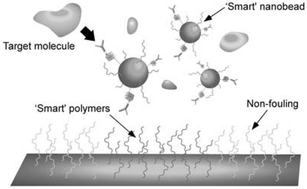Switchable surface traps for injectable bead-based chromatography in PDMS microfluidic channels
Abstract
We report here a reversible microchannel surface capture system for stimuli-responsive grafted bioanalytical beads. Poly(N-isopropylacrylamide) (PNIPAAm) was grafted onto polydimethylsiloxane (PDMS) surfaces by a UV-mediated graft polymerization from a photoinitiator that was preadsorbed in the channel wall. The surface grafting density and resulting switchable hydrophilic/hydrophobic properties were controlled by varying the photo-illumination times and/or the initiator concentration. At limiting PNIPAAm-graft densities, the surfaces demonstrated minimal contact angles of 35° below the lower critical solution temperature (LCST) and maximal contact angles of 82° above it. These contact angles could be varied depending on the graft density. The surface grafts are spatially limited to the photo-illuminated region to define where the trap is constructed. The surface traps capture PNIPAAm-grafted nanobeads uniformly above the LCST and facilitate their rapid release as the temperature is reversed to below the LCST. This dual surface trap and injectable chromatography system could be useful in many applications, such as affinity separations, immunoassays, and enzyme bioprocesses, by providing for the controlled capture and release of


 Please wait while we load your content...
Please wait while we load your content...